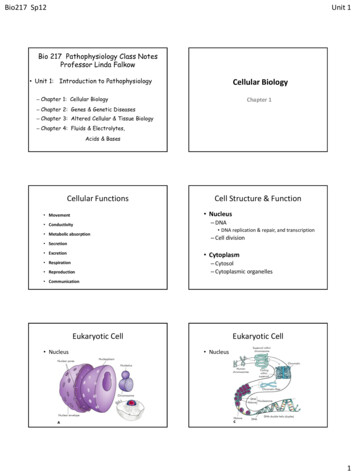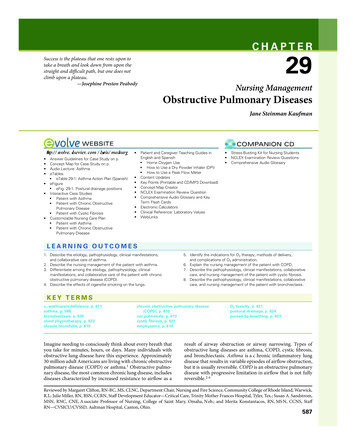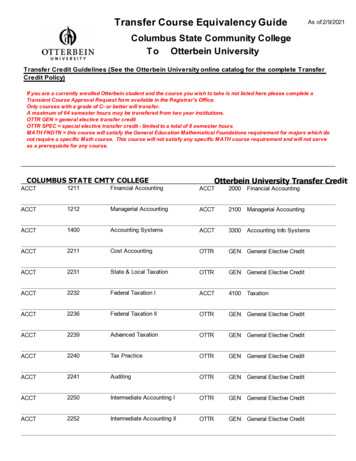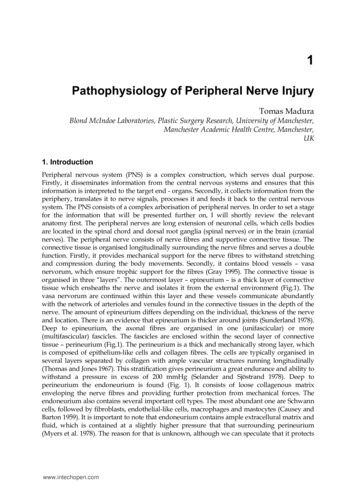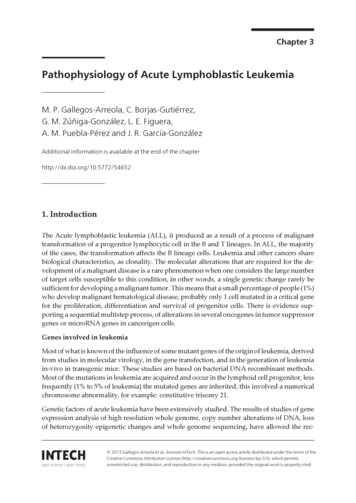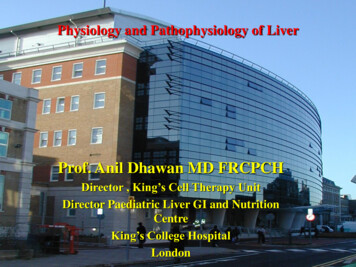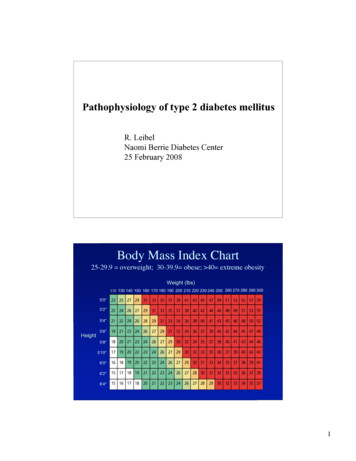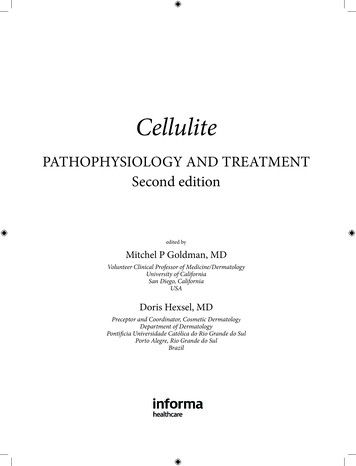
Transcription
CellulitePATHOPHYSIOLOGY AND TREATMENTSecond editionedited byMitchel P Goldman, MDVolunteer Clinical Professor of Medicine/DermatologyUniversity of CaliforniaSan Diego, CaliforniaUSADoris Hexsel, MDPreceptor and Coordinator, Cosmetic DermatologyDepartment of DermatologyPontificia Universidade Católica do Rio Grande do SulPorto Alegre, Rio Grande do SulBrazil
Table of contentsSeries introductionPrefaceList of contributors1.2.Social Impact of Cellulite and Its Impact onQuality of LifeDoris Hexsel, Camile Luisa Hexsel, andMagda B WeberPsychological Impact of Cellulite on the AffectedPatientsCristiano Brum3.Anatomy of Cellulite and the Interstitial MatrixPier Antonio Bacci4.Definition, Clinical Aspects, Classifications, andDiagnostic TechniquesDoris Hexsel, Taciana de Oliveira Dal’Forno, andRosemarie Mazzucoviviiviii13.Endermologie–LPG Systems“ after 15 YearsPier Antonio Bacci14.The Use of the Tri-ActiveTM in the Treatmentof CelluliteMitchel P Goldman158VelaSmooth and VelaShapeNeil S Sadick10816.Accent“ Unipolar RadiofrequencyJane Unaeze and David J Goldberg11517.Scientific Bases for the Use of Low-Level LightEnergy on the Treatment of CelluliteGordon H Sasaki120SmoothShapes“ Treatment of Cellulite and ThighCircumference Reduction: When Less Is MoreMichail M Pankratov and Serge Mordon1261319.Cellulite PathophysiologyZoe Diana Draelos246.Diagnostic TechniquesMolly Wanner and Mathew Avram277.8.Cellulite-Associated Clinical Conditions ofAesthetic InterestRosemarie Mazzuco and Taciana de OliveiraDal’Forno33Medical TherapyFabrizio Angelini, Carmine Orlandi,Pietro Di Fiore, Luca Gatteschi, Mirko Guerra,Fulvio Marzatico, Massimo Rapetti, andAttilio Speciani439.Topical Management of CelluliteDoris Hexsel, Débora Zechmeister do Prado, andMitchel P Goldman6210.Golden Lift“ in the Management of Cellulite:A New Member from the Golden Peel“ FamilyJosé Enrique Hernández-Pérez, MauricioHernández-Pérez, and EnriqueHernández-Pérez11.12.Injection Lipolysis for Body Sculpting and CelluliteReductionMartin BraunNo-Needle MesotherapyGustavo LeibaschoffHigh Frequency Ultrasound Evaluation ofCellulite Treated with the 1064 nm Nd:YAG LaserRégine Bousquet-Rouaud, Marie Bazan, JeanChaintreuil, and Agustina Vila Echague13620.Dermoelectroporation and Biodermogenesi“Pier Antonio Bacci14521.CarboxitherapyGustavo Leibaschoff15122.TriPollarTM RadiofrequencyWoraphong Manuskiatti15823.CryolipolysisTM for Subcutaneous Fat LayerReductionMathew Avram16824.Subcision“Doris Hexsel, Rosemarie Mazzuco, andMariana Soirefmann25.Surgical Treatment: Liposuction, Liposculpture, andLipoplasty180Gustavo Leibaschoff26.Study Protocols in CelluliteDébora Zechmeister do Prado, AmandaStapenhorst, and Marie-Laurence Abella27.Digital Photography and Other ImagingTechniques in CelluliteAna Beatris Rossi, Alex Nkengne, and 3v
13Endermologie – LPG Systems“ after 15 yearsPier Antonio Bacci, MDThe treatment Endermologie , patented by LPG-Systems (Valence,France) constitutes a true revolution in the field of the physicaltherapy both for clinical applications and aesthetics [1].After 15 years of experience, we can certainly affirm thismethodology as the most important basic treatment for cellulite.Associated to the mesotherapy, it allows us to treat different formsof cellulite offering various solutions, in the area of the aestheticand functional physiotherapy. It is the basic treatment aroundwhich we can rotate other necessary methodologies according tothe cases.This technique represents a revolution both in the principle and practical application of massage by maximizing thetraditional techniques of the physiotherapist. Endermologie is performed with unique equipment and various protocols fordifferent pathologies.The equipment consists of a patented tool, first instrumentwas named “Cellu M6 ” and its use provides various clinical andaesthetic solutions, but it requires training.After many experiences and studies, LPG company produceddifferent versions and today we have the most recent versionnamed “Keymodule 2i ” that allows stretching the skin in the various directions (Fig. 1). Endermologie shows a clinical efficacy incellulite linked with well documented circulatory, anti-edematous,dermotrophic and lipolytic properties [2–9].The modern instrument changes the use and the methodologybecause we have a sophisticated control of the different actions,an easy application of treatments and the possibility to choose thebest probe for different areas and indications (Fig. 2).New Keymodule 2i maintains the same first idea using onlycompressed air, it aids the performance of various physiotherapeutic maneuvers such as pumping, draining and stimulating thevascular system.The first maneuver is directed to muscles and tendons, thesecond is mostly directed to lipodermal tissues. These maneuversfavor emptying of the venous and lymphatic systems with themanual techniques described by Casley –Smith, Foldi andLeduc [10–12].The fingers of the physiotherapist can perform maneuvers ofgrazing, pinching, slurring, compression and rotation of the tissues, in additional to the classical “paper-roller” characterizedby movements of compression and rotation exploiting the elasticreturn of the tissue which also stimulates fibroblastic function.Endermologie treatment enhances the execution of thesame maneuvers and operations performed with the fingers.It’s therefore possible to perform stretching and traction at thesame time.The aspiration system of the machine lifts the skin andsubcutaneous tissue inside the motorized handpiece as the operator works rolling up and moving the handpiece in the desireddirections. The equipment software allows the operator to perform “compression-rotation” or “rhythmic compression-rotation”maneuvers. This allows the therapist an endless range oftherapeutic maneuvers to treat various pathologies or differentphases of a complex pathology. Such characteristics increase theindications and fields of application.To understand the concept and role of this complete andcomplex medical methodology it is necessary to describe thescientific principles and practical basis of some methods such asmassage and lymphatic drainage, focusing on some fundamentalprinciples of anatomy and physiology of the dermo-epidermaltissues.Anatomy and PhysiologyThe interstitial matrixThis constitutes and represents the true inside “sea” where all theexchanges and all the vital cellular regulations happen, wherelife begins and chronic illnesses and degenerative changes suchas the processes of aging occur. This is a substance that permeates every space and is found as a solution or gel. The principalcells that constitute it are the fibroblasts and the macrophagesbecause they provide continuous recovering of the tissue and toanti-inflammatory action.Adipose tissueAdipose tissue is, very probably, the most important tissue in thebody. It is a form of connective tissue with energetic formationregulatory functions [13–17]. The representative cell of this tissueis the adipocyte whose principal role is to maintain a reserve offat, in addition to acting as mechanical protection and assistingwith thermoregulation.The quantity of adipocytes varies between individuals andalso varies between regions of the body. The variability isbased on genetics [18,19]. Above the muscular fascia is a pillowof fat “parallel fat”, whose principal characteristic is reactivityto the food/caloric intake, constituting an important cause ofobesity. Some regions of the body possess subfacial fat thatis referred to as “steatomery.” It is slightly sensitive to caloricintake and insulin. To be able to lose 1 kg of steatomericfat one must lose 6 kg of systemic fat. Inside the abdomenanother type of fat, “intravisceral fat” also responds quickly tocaloric intake.Adipose tissue is connected to the endocrine system throughhormones that act on the metabolism of the fats. They are dividedinto two groups:1. lipoclastic hormones (catecholamine, adrenaline, glucagons,ACTH, TSH, thyroid hormones2. lipogenetic hormones (insulin, sex hormones, in particularestrogens)Endermologie acts on the skin and subcutaneous tissue,connective tissue, fat tissue and the microcirculation botharteriolar, venous and lymphatics [20,21].
Endermologie – LPG Systems after 15 yearsFigure 2 New instruments have different probes for different pathologies.Figure 1 Endermologie facilitates different activities.The Superficial Muscular FasciaTreatment of this fascia is very important to have the best resultsusing endermologie.Surgeons and anatomists have often ignored or denied theimportance of the superficial fascia of the body. For example, theanatomical layer on which liposuction or liposculpture occurs isreally the superficial fascia, considered sometimes as a systemicbandage: S.F.S. (Superficial Fascial System). An interesting anatomical and histological examination of the inferior limbs hasshown the presence of the “Superficial Fascia” as responsible fornumerous aesthetic alterations of the skin surface [22].The depressions and elevations of the contour of the body areexplained from the anatomy of the superficial fascia and fromits relationships with the skin, the fat and the musculo-skeletalsystem. The study of anatomy and the understanding of physiopathological exchanges of the superficial bandage system are notonly the basis for surgical correction of the silhouette, but aboveall the basis for recovery in osteopathic therapies.The Argentineans, Moretti, Schapira and Kaplan have studied20 patients, 10 males and 10 females withdrawing one “lozenge”of 20 cm of length for four of width in the zone along the sideand the knee. Their anatomical study found the presence of anet of connective tissue that extends from the subdermal planeto the muscular aponeurosis [23]. It is really this net that constitutes the true superficial band and it is formed from varioushorizontal septa of collagen and elastic fibers separated by fatlobules and always crossed vertically by septa type fibers. At thesubdermal level, the presence of the superficial fascia also constitutes a connection with the deep dermis with bigger fibroussepta woven among them in such way to provoke the separationof adipose tissue in small compartments that organize the superficial adipose tissue with the classical structure of a honeycombof bees.This structural configuration constitutes the “bundle-dermalsystem”, of great functional importance.Even if anatomically a real plane of separation is not obser vedamong the superficial muscular fascia and the connectivefibers of the deep dermis we can deduce that, functionally andhistologically, the continuous imbrications of fibers collectivelyconstitute this “hypodermic superficial fascia”.In thin patients the superficial band is well delineated and ofwhitish color. In obese patients the great quantity of adipose tissuestretches the superficial fascia and attenuates the end making itdifficult to recognize. The connective and elastic fibers are dilutedin the fat fabric and this can explain the error of some studies,ones that put doubts on the existence of this superficial band.Without doubt, in the facial zone in men over the iliac crestappears as a deep band that is not found in the female sex. Inthe women, instead, the fibrous band appears with the muscularaponeurosis at a level of the subgluteous that constitutes the basefor the adipose tissue situated in this zone. This difference explainsthe difference in the contour of the gluteus among the two sexes.The skin, the superficial fascia and the superficial fat must tobe considered as a system of protection and functional support.This functional unity constitutes the support of the adipose fabricand helps to prevent the abnormal location of this fabric in otheranatomical regions. The traction and stretching of the superficialfacial band and the superficial muscular fascia with Endermologieis essential in the treatment.MassageMassage is an art, more than a therapeutic action that comprisesa feeling between the hand of the operator and the tissues of thepatient that must not be traumatized, but instead revascularized,stimulated and cleansed. A well done massage has to relax the bodyand the mind to increase the skin temperature with stimulation ofthe microcirculation which favors intercellular exchange. A globalmassage of the body can have a sedative action and, at the sametime, stimulate the nervous system. But massage doesn’t have to beviolent or prolonged to avoid provoking lymphatic congestion.Manual Lymphatic DrainageLymphatic drainage is a physical method to reduce the stasis ofthe lymphatic fluid and the toxic substances in the tissues. Lymphatic drainage is not traumatic but a gentle massage technique.
Cellulite: Pathophysiology and TreatmentFigure 3 Endermologie allows a traction of the skin and connective fibers.Manual lymphatic drainage has its scientific basis in the study andteachings of Foldi and Leduc [24,25].It deals with a series of grazing and compressions on the lymphatic system to improve lymphatic flow. In the technique ofVodder lymphatic drainage becomes less physician and moreaesthetic in nature. Periodic cycles of manual lymphatic drainageare recommended according to Vodder, particularly to maintainthe tissues from free from lymphatic congestion. We believe thatmanual lymphatic drainage performed with the hands is the onlyone that can give acceptable results.The Technique “Endermologie“”History and principlesOur experience with the LPG-System began in 1993. The Frenchengineer, Louis Paul Guitay (LPG), developed a system to helpcare of fibrosis he developed as a result of violent trauma thatresembled the movement performed by his therapist’s fingers,including additional effects.Sophisticated software allows for possible phases of continuous and sequential aspiration with mobilization of the tissues,offering the therapist an endless range of possibility of interventions appropriate for various pathologies. So began a truerevolution in physiotherapy. Today scientific research has confirmed the effectiveness of this method [2–9]. This revolutionhas also given birth to an important professional team formedby doctor/surgeon and physiotherapist, a union that is importantin the fields of the phlebolymphology.What is endermologieIt is patented equipment that works with two motorized rollersbetween a vacuum suction with varying programs that lifts theskin reaching the deepest structures (Figs 3–4).The hands of the therapist can be helped by the integratedaction of this equipment allowing one to make the same physiotherapy maneuvers enriched by stretching the cutaneous fabrics tobe able to work more deeply. The effect is mainly the stimulationof cellular metabolism (fibroblasts, adipocytes) and the vascularisation with lymphatic drain and a purification through manuallymphatic drainage. To ensure proper treatment one must have:1. Correct diagnosis to be able to apply the therapy or the fittestprogram2. Qualified PersonnelMechanism of actionEndermologie possesses five complementary actions that allowtreatment of different types of tissue:1. Mobilization of the tissues that characterize the differentstructures with consequent activation of the arteriolar microcirculation2. Traction of the connective tissue with exercise of the skin3. Activation of the reflected arcs and stimulation of fibrousbanding4. Neurometabolic regulation with metabolic activation5. Rhythmic compression of the tissues with lymph drainageFigure 4 Different directions of the rotation facilitates different activities.
Endermologie – LPG Systems after 15 yearsTogether the stretching and the rhythmic compression ofconnective tissue activate fat lobules to cause their shrinkagewith stretching of the fibrous septae.The mechanical stimulations act on the mechanoreceptorssuch as:1. corpuscles of Meissner, sensitive to the light stimulations withactivation of the fibroblasts2. corpuscles of Water-Pacini, that are found in the deepdermis and in the lipoderma are sensitive to deep pressureof the skin and vibration. They stimulate the activity of thefibroblasts3. corpuscles of the Golgi, sensitive to the light pressures, theystimulate fibroblasts and the regeneration of the collagenand connective tissue4. corpuscles of Merkel, situated in the epidermis, are sensitiveto the vibrations and the light pressure. They act on cellularmetabolic activityThe hyperdistension of the subcutaneous tissue will activatethe specific receptors to free substances such as the bradychinen,histamine, serotonin and catecholamines. These have action onbeta adrenergic receptors activating the adenocyclase with anincrease of the AMP to increase of tissue AMP which in turnstimulates protein kinase that activates intra-adipocytic lipasewith hydrolytic action on the triglycerides of the fat cells.To conclude, different methodologies can have different results(Fig. 5).You could hypothesize two principal actions.The lightest treatment stimulates Golgi complexes to provoke:1. Vascularisation2. Stimulation of the receptors Lipoclasis3. Stimulation of the fibroblasts Restructuring connectivetissueThus stimulation of the beta adrenergic receptors occurs with1.2.3.4.Lipolytic actionIncrease tissue AMPHydrolytic intra-fat actionRestructuring of connective tissueThe strongest and deepest treatment, with stimulation of thePacini corpuscles provokes liberation of bradichinen, histamine,serotonin and catecholamine with:1. Increase free radicals2. Alteration matrix3. Flogosis4. FibrosisThen we have a direct action on cicatrisation rather than towarda restructuring.Treatment phaseThe physician and operator act as a team. The actual procedure can be performed by the physiotherapist or osteopathafter the diagnosis is pointed out by the physician specialized inPhlebology, in the case of pathologies of the venolymphaticsystem or from the Dermatologist or Cosmetic Surgeon, in thecase of burns or scars that introduce fibrous retractions.Various phases of application are:1. Vascularising phase, to reactivate the cutaneous micro circulation2. Drainage phase, to drain the lymphatic stagnation3. Stimulation phase, to stimulate the fibroblasts and theinterstitial neurophysiologic systems4. Invigorating phase, to stimulate the skin5. Exercise phase, in which the patient actively collaborateswith isometric contractions pointed out by the operator toproduce tissue and muscle tonification6. Visceral phase, always with the collaboration of the patientalong with specific maneuvers to stimulate abdominalvisceral activities7. Lipomassage phase, to increase the metabolism of the fattissueIndicationsa) PhebolymphologyThis treatment enhances the possibilities offered by traditionalmanual lymphatic drainage overcoming the traditional concept of“emptying of the lymphatic vessels” with the concept of metabolicstimulation.Unlike the traditional therapies, performing the lymphaticdrainage with Endermologie , allows one to possibly reduce thenecessity for high compression stockings or elastic bandages.This means that the mechanism of action of treatment includesactivation of the autonomous nervous system and the interstitialconnective tissue [26–29].b) Plastic and aesthetic surgeryThe method here is a natural complement of liposculpture recovering and remodeling the fat tissue decreasing complications(irregularities). In addition, Endermologie will decrease theFigure 5 Any type of the skin can have his best treatment.
Cellulite: Pathophysiology and Treatmentincidence of seromas, edemas, alterations of the skin (fibrosisand asymmetries) [30–34].c) Cellulitic syndromesAs discussed in previous chapters, cellulite is a condition comprised of various pathological expressions of vascular and/ordegenerative alterations of the connective tissue or interstitialmatrix, often in partnership with lipotrophy of the musculartissue. Cellulite should not be confused with obesity.Obesity is when the fat tissue is above 30% of the quantitythat can normally be present, while cellulite is a transformationand an alteration of subcutaneous interstitial tissues [35–45].Endermologie provide us the basic treatment around whichmany methodologies may be associated for a complete andstudied integrated protocol of treatment.In addition to aesthetic alterations, various subjective symptomsexist including cramps, pain to the touch, heaviness, livedo reticularis, edemas and tiredness. Such symptoms represent importantdiagnostic signs for the various cellulitic pathologies that areclassified in five fundamental groups [46–48].1) Edematous celluliteCharacterized by orange peel skin provoked by the stretchingof the connective fibers due to an excess of liquid. The principal symptoms are: pain, edematous plasticity, sense of periodicswelling and edema of the ankle.2) Adipose celluliteCharacterized by the skin stretched by an excess of adipose tissue,with particular increase of the fat “steatomery”. There are no imbibitions of interstitial liquid, it is associated with being overweight.Orange-peel skin is caused by the stretching of connective tissue dueto an excess of fat tissue. The principal symptoms are no pain, noedema and no sense of periodic swelling.3) Interstitial celluliteCharacteristic of young subjects is the typical lipoedema whichis characterized by the superficial tissue of the thigh imbibedwith fluid and superficial adipose tissue. Orange peel skin iscaused by the stretching of connective tissue from edema andfat tissue.The principal symptoms are pain and edema to the thigh, butnot the leg or foot. There is often a sense of swelling to the hands[49–53].4) Fibrous celluliteThe pathophysiologic point of view is characterized by dehydration of the cutaneous and fibrous connective tissue and fat withthe development of nodules of adipose tissue surrounded bya sclerotic capsule. The orange peel appearance of the skin iscoarse and caused by the retraction of connective tissue fibers.The principal symptoms are pain without edema.5) Localized adiposityThey are lipomatosis and localized adiposity in subcutaneoustissue or in the splitting of the superficial fascia. Their anatomic,physiologic and pathologic evidence are completely different from Figure 6 Endermologie treatment may be useful for care or maintenance.the cellulite. The surgeon will proceed to eliminate the localizedadiposity through excision or liposculpture.Today we use frequently a lipolaser with microfibra of 100–200 micron connected by the Eufoton laser 940 nanometeres,using this methodology we can reduce the traumatic action ofcannulas and improve the retraction avoiding the irregularities ofthe skin.After surgical treatment of liposculpture or mini invasivetreatment by lipolaser we can add six to eight sessions of Endermologie to complete the treatment and to have the best resultsin short time. The therapist will begin treatments with lymphaticdrainage that aids in recovery.Endermologie can offer the possibility of good results withoutsurgical treatment in selected patients because we can reducea fat layer using a particular treatment named Lipomassage. Infact, new Keymodule stimulates fat tissue increasing its metabolicactivity and reducing its quantity with a good aesthetic result.The methodEndermologie is ideal in the treatment of the different forms ofcellulite but precise protocols of technique are necessary [54,55].Three fundamental rules to provide correct treatment: are no pain,no persistent vascularisation and a fluidity of the massage techniquefrom the operator. The therapist doesn’t have to provide a strongtraction with the rollers, on the contrary, the technique should belike a fluid sliding on the Body garment. Another important rule isto position the machinery at the foot of the table on the left.Positioning Keymodule in this manner allows the operator touse both hands to massage the patient in a superior – inferiordirection (Fig. 6).All the necessary maneuvers are performed, with slow movements in the descending phase, respecting the tissues andfavoring the lifting and tonification. The manipulation of thehead must be compared to a painter’s brush that has to cover thewhole surface of the body within every treatment session.In patients with predominant veno-lymphatic stasis, it isnecessary to begin the treatment from the abdomen, treating it
Endermologie – LPG Systems after 15 yearsFigure 7 We can havegood result in local adiposity too.in such way as to prepare the lymphatic vessels to drain from thewhole body as well as stimulate the muscular fascia, perivisceralfascia (kidney and peritoneum) and the suspensor ligaments ofthe colon and liver.The standard time of treatment, applicable to most cases isof 35 minutes. More time may be devoted to subjects notablyoverweight where it is necessary to work on a single part of thebody. Whatever the constitution and problem it is always best totreat the whole body (Fig. 7).If we suggest a good nutrition with a reduction of carbohydrates to low stimulation of insulin, our results will be fast andincreased (Fig. 8).Figure 8 The association with protheic nutrition is very interesting.
Cellulite: Pathophysiology and TreatmentEndermologie treatment aims to bring plasticity, elasticityand compactness to the skin and subcutaneous tissue, thanks tothe stimulation of connective tissue. The variations of techniquefollow the clinical indications.ConclusionsEndermologie - LPG System certainly is not a panacea for all thepathologies but it is a real revolution in the field of the physicalmedicine, of physiotherapy and aesthetical physiotherapy [56,57].The method one doesn’t consist of a massage but a real treatment. To massage means to perform a local stimulation with alocal result. To make a treatment means to perform a systemic andlocal stimulation with systemic and local results.The use of Endermologie never foresees the execution ofa massage or a lymphatic drainage but the execution of a treatment finalized to the metabolic recovery and the stimulation ofconnective tissue. This aspect represents the revolution andthe great difference is in comparison to the manual lymphaticdrainage. This is appropriate for cellulitic syndromes.Endermologie is a natural complement to cosmetic and plasticsurgery in the treatment of lipodistrophy and cellulite as well asvarious forms of edema and lipolymphedema [58,59]. Endermologie, for the first time, offers a particularly active treatmentin the activation of fibroblasts and the metabolism of the interstitial matrix and, actually, it represents the more important basictreatment for different forms of cellulite.Particular biopsy shows the possibility to have a new activity ofthe dermis and subcutaneous layer demonstrated by an improvedreticular dermis layer.All other methodologies can be integrated with Endermologieto have best results and few complications [60–63].[AQ1]References1. PA Bacci. Il ruolo della metodologia “Endermologie ”, in“Le celluliti nel 2004”, Minelli Editore, Arezzo; 2004.2. C Monteux, M Lafontan. Use of the microdialysis techniqueto assess lipolytic responsiveness of femoral adipose tissueafter 12 sessions of mechanical massage technique. JEADV22:1465–1470, 2008.3. JF Bourgeois et al. A randomized, prospective study usingthe LPG Technique in treating radiation-induced skin fib rosis. Clinical and Profilometric analysis. Skin Research andTechnology 14:71–76, 2008.4. AL Moseley et al. Comparison of the effectiveness of MLDand LPG Technique. Journal of Lymphoedema 2007, Vol 2,N 2, 30–36.5. JP Ortonne et al. Treatment of cellulite: Effectiveness andsustained effect at 6 months with Endermologie demonstrated by several quantitative evaluation methods. Nouv.Dermatol 23:261–269, 2004.6. D Innocenzi et al. Evidenza delle modificazioni cutaneeindotte dalla tecnica LPG mediante analise d’immagine.DermoCosmetologia Anno II, n 1 – Gennaio/Marzo; 2003:p. 9–15.7. PA Bacci et al. Vibroassisted Liposuction and Endermologie for LipoLymphedema. The European Journal of Lymphology– Vol. X – Nr. 35–36, p16, 2002. 8. D Adcock et al. Analysis of the effects of deep mechanicalmassage in the porcine model. Plast. Reconstr Surg 108(1):233–40, Jul 2001.9. P Lattarulo et al. Physiological tissue changes after administration of micronized Diosmin/Hesperidin, individually orin association with Endermologie . International Journal ofAesthetic Cosmetic Beauty Surgery Vol. 1, n 2, p. 25–28, 2001.10. JR Casley – Smith. Lymph and lymphatic, in “Microcirculation” by G Kaley. and Altura Eds, Vol.I, University Park Press,Baltimore, Maryland; 1977: 423–508.11. M Foldi. Therapy of secondary lymphoedema, Med. Welt28(41):669–1670, 1977.12. A Leduc. Il drenaggio linfatico, Masson Italia editore, Milano;1982.13. P Ball, R Knuppen et al. Interactions between estrogens andcathecolamines. J Clin Endocr 34:736, 1972.14. P Bjorntorp. The fat cells, a clinical view, Recent advances inII Obesity 1978.15. P Bjorntorp, L Sjostrom. Number and sizes of adipous tissuefat cells in relation to metabolism in human obesity. RevMetabolism 1972.16. J Brunzel. Insulin and adipose tissue, International Journal ofobesity 1981.17. J Vague, P Bjorntorp. Metabolic complications of humanobesities, Ph. Vague (Eds). Excerpta Med., Amsterdam; 1985.18. J Vague. Las obesidades, Cuadernos de medicina estetica,Solal – Masson (Ed.) Marseille France; 1990: n. 3.19. JM Fain, RE Sheperd, Hormonal regulation or lipolysis. AdvExper Med Biol 111:43–79, 1979.20. D Adcock, S Paulsen, RB Shack et al. Analysis of the cutaneous and systemic effects of Endermologie in the porcinemodel, Aesthetic Surgery Journal. USA 18(6):414–422, 1998.21. PB Fodor, J Watson, W Shaw et al. Physiological effectsof Endermologie: a preliminary report, Aesthetic SurgeryJournal. USA 19(1):1–7, 1999.22. PA Bacci. La fascia superficiale in “Bacci P.A.” –“Le celluliti”,Alberti & C. Editori, Arezzo; 2000
11. Injection Lipolysis for Body Sculpting and Cellulite Reduction 74 Martin Braun 12. No-Needle Mesotherapy 86 Gustavo Leibaschoff 13. Endermologie-LPG Systems" aft er 15 Years 91 Pier Antonio Bacci 14. Th e Use of the Tri-ActiveTM in the Treatment of Cellulite 99 Mitchel P Goldman 15. VelaSmooth and VelaShape 108 Neil S Sadick 16.
